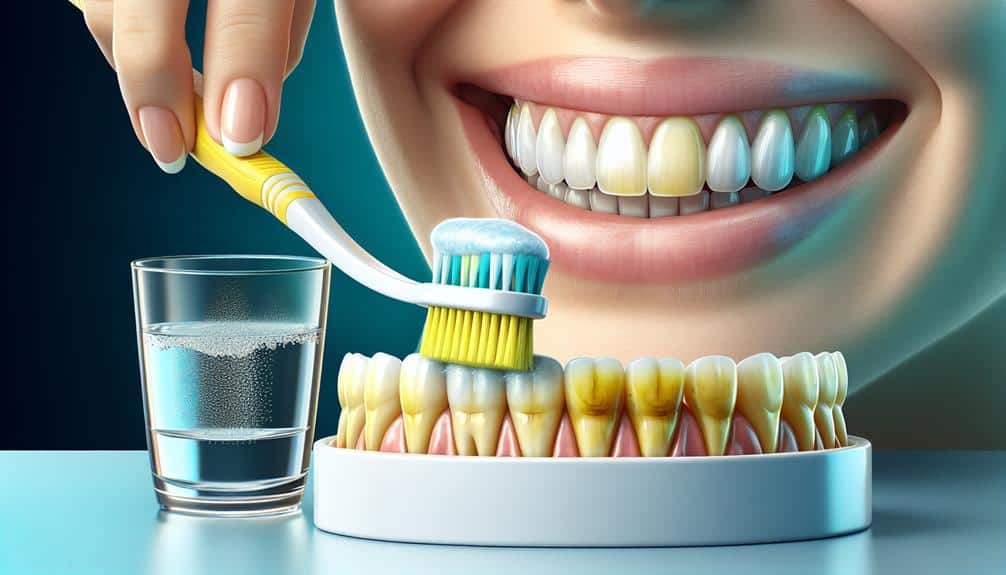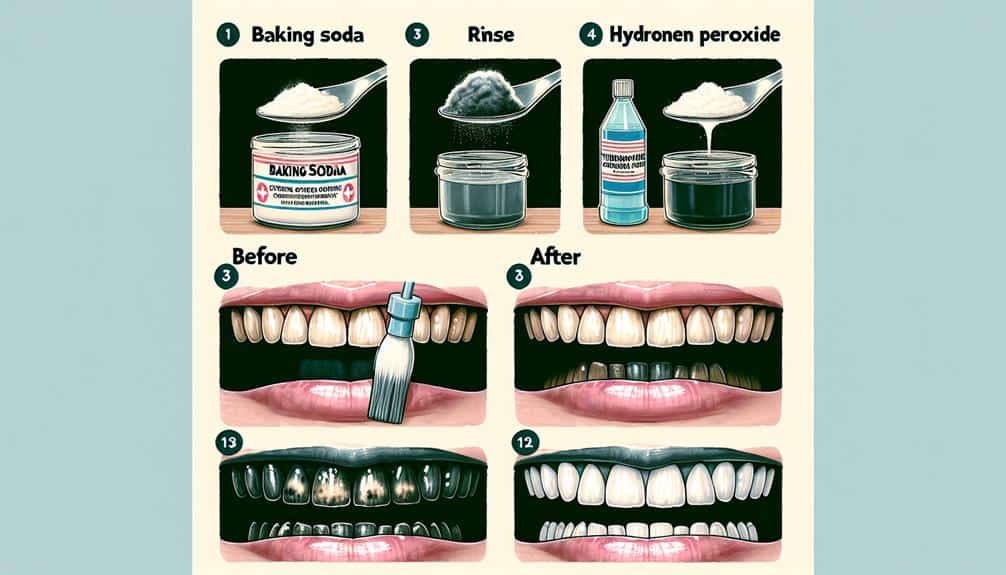For the ultimate tetracycline stain removal, consider professional dental whitening with laser treatments. These in-office procedures use concentrated bleaching gel and advanced technology to guarantee effective stain elimination. At-home whitening kits offer flexibility, but remember consistency is key for optimum results. Additionally, don't underestimate the power of natural remedies like baking soda for scrubbing away surface stains or oil pulling with coconut oil to remove toxins. These methods complement each other in fighting tetracycline stains. Discover the top 3 methods for banishing these stubborn stains with expert-backed revelations that promise flawless results.
Key Points
- Professional dental whitening known for tetracycline stain removal with laser technology.
- At-home whitening kits provide convenience and gradual whitening for healthier teeth.
- Natural remedies like baking soda and oil pulling offer gentle stain removal.
- Laser whitening accelerates deep-set stain removal process effectively.
- Consistency is crucial for optimum results in tetracycline stain removal.
Professional Dental Whitening
To effectively eliminate tetracycline stains, professional dental whitening procedures offer a reliable solution for restoring a brighter smile. In-office treatments, such as laser whitening, are a popular choice for individuals seeking quick and effective results. During an in-office whitening session, a highly concentrated bleaching gel is applied to your teeth. The laser is then used to activate the gel, allowing it to penetrate the enamel and break down the stubborn tetracycline stains.
Laser whitening, in particular, is known for its ability to target deep-set stains effectively. The concentrated light energy from the laser activates the bleaching agent, accelerating the whitening process. This advanced technology ensures that the tetracycline stains are lifted, revealing a whiter and brighter smile.
Professional dental whitening treatments are performed under the supervision of trained professionals, ensuring safety and excellent results. By opting for in-office treatments like laser whitening, you can achieve significant improvements in the appearance of your teeth in just one session.
At-Home Whitening Kits
For effective teeth whitening at your convenience, consider utilizing at-home whitening kits. These kits offer a convenient way to brighten your smile without the need for frequent visits to the dentist. Here are some key points to keep in mind when using at-home whitening kits:
- DIY Treatments: At-home whitening kits provide you with the flexibility to whiten your teeth on your own schedule. By following the instructions carefully, you can achieve noticeable results in the comfort of your home.
- Product Reviews: Before purchasing an at-home whitening kit, it's important to read reviews from other users. Look for products with positive feedback regarding effectiveness, ease of use, and minimal side effects. This will help you choose a reliable and safe whitening kit for your needs.
- Consistency is Key: To achieve the best results, consistency is vital when using at-home whitening kits. Follow the recommended treatment schedule and be patient, as gradual whitening is often more sustainable and healthier for your teeth in the long run.
Natural Remedies
Consider incorporating natural remedies into your dental care routine for a gentler approach to teeth whitening. Home remedies can provide DIY treatments with effective results, offering a more natural alternative to commercial products. One popular natural remedy for tetracycline stain removal is baking soda. Its mild abrasiveness can help scrub away surface stains and brighten your teeth. Mix a small amount of baking soda with water to form a paste, then gently brush your teeth with it a few times a week for long-lasting effects.
Another beneficial natural remedy is oil pulling, a traditional Indian practice that involves swishing oil around your mouth to remove toxins and bacteria. Coconut oil, in particular, is often used for this purpose and is believed to help whiten teeth over time. Simply swish a tablespoon of coconut oil in your mouth for about 15-20 minutes before spitting it out. Incorporating these natural remedies into your routine can complement your efforts to reduce tetracycline stains and achieve a brighter smile.
Frequently Asked Questions
Are There Any Specific Dietary Restrictions or Lifestyle Changes That Can Help Prevent Tetracycline Stains From Reoccurring After Treatment?
To prevent tetracycline stains from reoccurring after treatment, consider incorporating preventive measures into your routine. Lifestyle changes, such as avoiding foods and beverages that can stain teeth and maintaining good oral hygiene, can help maintain a bright smile.
Can Tetracycline Stains Be Completely Removed With Just One Treatment, or Is Multiple Sessions Required?
Can those stubborn tetracycline stains vanish in a single treatment, or will you need multiple sessions? Success rates vary; some may find satisfaction after one session, while others may require more for complete removal. Consider treatment duration and cost effectiveness.
Are There Any Potential Side Effects or Risks Associated With Tetracycline Stain Removal Treatments?
When addressing tetracycline stain removal, it's vital to take into account possible side effects and risks. Risk evaluation and skin sensitivity should be assessed. Long-term impacts and treatment effectiveness are paramount for a successful outcome.
Are There Any Alternative Treatments for Tetracycline Stains That Do Not Involve Whitening Agents or Chemicals?
When looking for alternatives to traditional stain removal methods, consider trying natural remedies or DIY solutions. Home remedies can offer non-invasive approaches to tackling tetracycline stains without the use of harsh chemicals or whitening agents.
How Long Do the Results of Tetracycline Stain Removal Treatments Typically Last Before Needing Touch-Ups or Maintenance?
Achieving lasting results in tetracycline stain removal hinges on the treatment's durability and maintenance needs. Touch-up frequency varies based on individual factors. Consistent care and follow-up appointments are essential for sustaining long-term efficacy.



